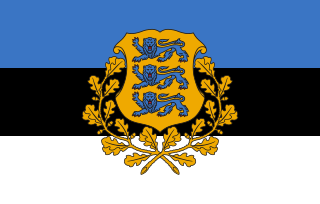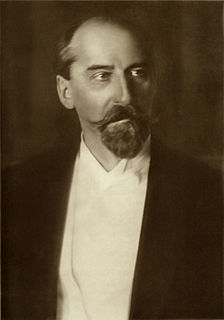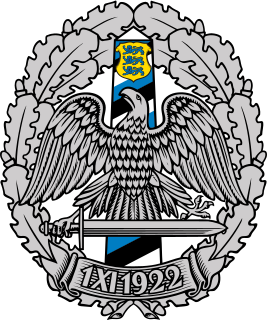| |||||
| Decades: | |||||
|---|---|---|---|---|---|
| See also: | |||||
This article lists events that occurred during 1933 in Estonia .
| |||||
| Decades: | |||||
|---|---|---|---|---|---|
| See also: | |||||
This article lists events that occurred during 1933 in Estonia .
Politics in Estonia takes place in a framework of a parliamentary representative democratic republic, whereby the Prime Minister of Estonia is the head of government, and of a multi-party system. Legislative power is vested in the Estonian parliament. Executive power is exercised by the government, which is led by the prime minister. The judiciary is independent of the executive and the legislature. Estonia is a member of United Nations, the European Union, and NATO.

The United Baltic Duchy, or alternatively the "Grand Duchy of Livonia", was the name proposed during World War I by leaders of the local Baltic German nobility for a new monarchical state which, however, never came into existence. The unsuccessful attempt to establish a new German client state on the territory of what is now Latvia and Estonia was made in 1918, during the German occupation of the former Courland, Livonian, and Estonian governorates of the Russian Empire which had ceased to exist after the Bolshevik coup in 1917. The unsuccessful proclamation of a pro-German duchy was first made in April 1918, after the Republic of Estonia had already formally declared full independence from the warring Russian and German Empires.

The Prime Minister of Estonia is the head of government of the Republic of Estonia. The prime minister is nominated by the president after appropriate consultations with the parliamentary factions and confirmed by the parliament (Riigikogu). In case of disagreement, the Parliament can reject the president's nomination and choose their own candidate. In practice, since the prime minister must maintain the confidence of Parliament in order to remain in office, they are usually the leader of the senior partner in the governing coalition. The current prime minister is Kaja Kallas of the Reform Party. She took the office on 26 January 2021 following the resignation of Jüri Ratas.

Konstantin Päts was an Estonian statesman and the country's president in 1938–1940. Päts was one of the most influential politicians of the independent democratic Republic of Estonia, and during the two decades prior to World War II he also served five times as the country's prime minister.

The president of the Republic of Estonia is the head of state of the Republic of Estonia. The current president is Alar Karis, elected by Parliament on 31 August 2021, replacing Kersti Kaljulaid.

Jaan Tõnisson was an Estonian statesman, serving as the Prime Minister of Estonia twice during 1919 to 1920, as State Elder from 1927 to 1928 and in 1933, and as Foreign Minister of Estonia from 1931 to 1932.
The Head of State of Estonia or State Elder was the official title of the Estonian head of state from 1920 to 1937. He combined some of the functions held by a president and prime minister in most other democracies.
Constitution of Estonia is the fundamental law of the Republic of Estonia and establishes the state order as that of a democratic republic where the supreme power is vested in its citizens. The first Constitution was adopted by the freely elected Estonian Constituent Assembly on 15 June 1920 and came into force on 21 December 1920. Heavily amended on 24 January 1934, following a referendum in 1933, it was in force until the second Constitution was enacted on 1 January 1938. It remained in force, de facto, until 16 June 1940, when the Soviet Union occupied Estonia and, de jure, until 28 June 1992, when the third and current Constitution of the Republic of Estonia was adopted by referendum.

The Estonian government-in-exile was the formally declared governmental authority of the Republic of Estonia in exile, existing from 1944 until the reestablishment of Estonian sovereignty over Estonian territory in 1991 and 1992. It traced its legitimacy through constitutional succession to the last Estonian government in power prior to the Soviet invasion of 1940. During its existence, it was the internationally recognized government of Estonia.

The Estonian Border Guard was the national security agency responsible for the border security of Estonia. It was subordinate to the Ministry of the Interior. The Border Guard also assisted with Search and Rescue missions. In 2010, the organization was superseded by the Police and Border Guard Board.

Estonia, formally the Republic of Estonia, is a country by the Baltic Sea in Northern Europe. It is bordered to the north by the Gulf of Finland across from Finland, to the west by the sea across from Sweden, to the south by Latvia, and to the east by Lake Peipus and Russia. The territory of Estonia consists of the mainland, the larger islands of Saaremaa and Hiiumaa, and over 2,200 other islands and islets on the eastern coast of the Baltic Sea, covering a total area of 45,339 square kilometres (17,505 sq mi). The capital city Tallinn and Tartu are the two largest urban areas of the country. The Estonian language is the autochthonous and the official language of Estonia; it is the first language of the majority of its population, as well as the world's second most spoken Finnic language.
The 2013 Meistriliiga was the 23rd season of the Meistriliiga, the first level in the Estonian football system. The season began on 2 March 2013 and ended on 9 November 2013. Nõmme Kalju, the defending champions, finished runners-up behind Levadia, who won their 8th title.
The 2014 Meistriliiga, also known as A. Le Coq Premium Liiga due to sponsorship reasons, was the 24th season of the Meistriliiga, the first level in the Estonian football system. The season ran from 1 March 2014 to 8 November 2014. Levadia successfully defended the title, securing the championship in the last round.
The Estonian Constituent Assembly was elected on 5–7 April 1919, called by the Estonian Provisional Government during the Estonian War of Independence.
The 2015 Meistriliiga, also known as A. Le Coq Premium Liiga for sponsorship reasons, was the 25th season of the Meistriliiga, the first level in the Estonian football system. The season started on 6 March 2015 and the final matchday took place on 7 November. Levadia, the defending champions, finished runner-up behind Flora, who won their tenth title.
The 2016 Meistriliiga was the 26th season of the Meistriliiga, the highest division of Estonian football system. The season began on 4 March 2016 and concluded on 5 November 2016.

The Commander of the Defence Forces is the Chief of the Estonian Defence Forces and the national defence organisations.
The 2018 Meistriliiga was the 28th season of the Meistriliiga, the highest division of Estonian football system. The season was scheduled to begin on 25 February 2018, but was postponed due to a cold wave. On 3 March, the season began with four out of five second round matches held in indoor arena. This marked the first time Estonian league football was played indoor. The season concluded on 10 November 2018. Flora were the defending champions. Nõmme Kalju won their 2nd Meistriliiga title completing an entire season undefeated.
The 2019 Meistriliiga was the 29th season of the Meistriliiga, the top Estonian league for association football clubs. The season began on 8 March 2019 and concluded on 9 November 2019. Nõmme Kalju were the defending champions. Flora won their 12th Meistriliiga title.
The 2022 Meistriliiga, also known as A. Le Coq Premium Liiga due to sponsorship reasons, is the 32nd season of the Meistriliiga, the top Estonian league for association football clubs since its establishment in 1992. The season started on 1 March 2022 and will conclude on 12 November 2022.